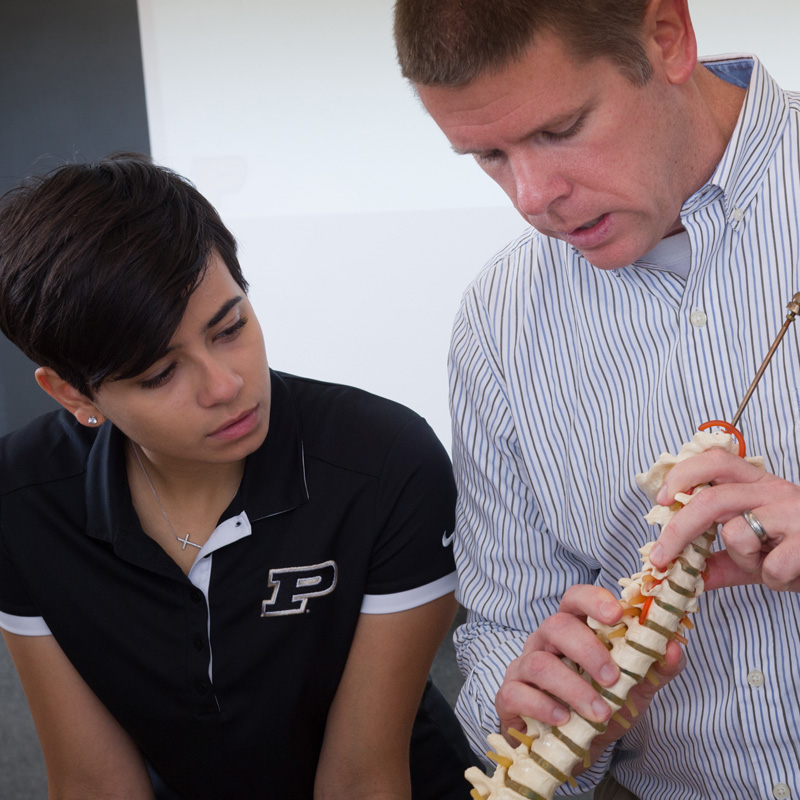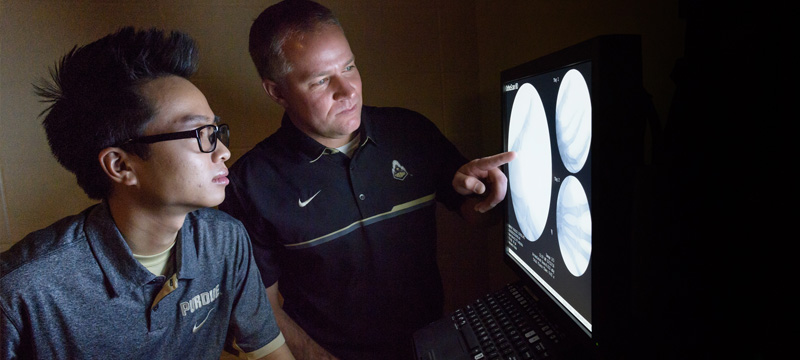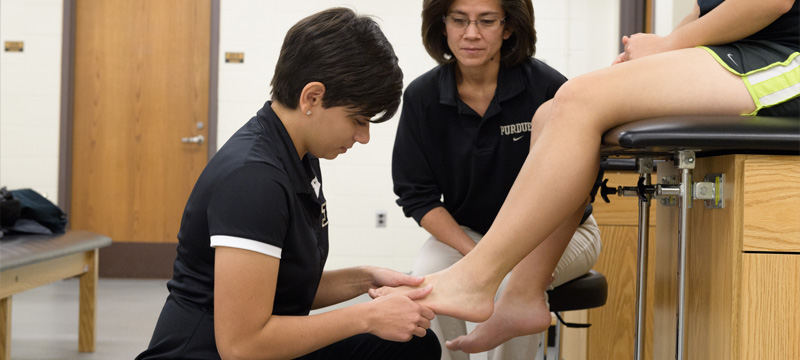Partnership Between Physical Therapy and Athletic Training is One Small Step in Pain Relief

According to the Centers for Disease Control, chronic pain affects the well-being of more than 50 million adults across the United States.1 If we add the annual estimated 2.9 million nonfatal workplace injuries,2 8.6 million athletic injuries3 and incalculable general injuries, we see a nation in a lot of pain.
Training students to ease this pain is a co-curricular partnership between Purdue's Athletic Training program and Purdue University Student Health Service (PUSH) Physical Therapy. The Physical Therapy (PT) Clinic, overseen by Director of Physical Therapy Jeff Stein (PT, ATC, DPT) and located in the CoRec Wellness Suite, serves as a clinical site for students enrolled in the Athletic Training program, an academic major in the Department of Health & Kinesiology. The partnership places students into the PT clinic where they work alongside an experienced team of doctors of physical therapy, contributing to every aspect of patient care.
By supplementing traditional coursework with hands-on work in a physical therapy clinic, the Athletic Training program is coaching students in making the next giant leap in patient care. Students are challenged with developing therapy sessions and regimens based on research, their academic training, and -- the most complex element -- needs of individual patients.
“Looking back, the PT environment provided space for students to grow in creativity and their confidence in clinical decision making,” cites program alumna Kara Kershner (LAT, ATC).
Students engaged in the Physical Therapy program learn quickly that there is no one-size-fits-all in the pursuit of pain relief and that critical thinking is as essential as memorizing anatomy lessons.
“Three plus three will always give you six. However, working with people is another story entirely,” says Kershner. “Knowing your patient’s goals and giving them a voice in their treatment plan helps increase rapport and compliance. You begin to see that three plus three equals six, but so does one plus five and two plus four.”
The persistent pursuit of healthier communities means helping more than just athletes. Senior Ben Patrick says the Physical Therapy program was an invaluable addition to his athlete-specific fieldwork.
“In athletics I am exposed to acute or traumatic injuries primarily, but during my time with PUSH PT, I dealt with lots of chronic conditions, post-operative care, and functional limitations,” says Patrick.

The co-curricular nature of the program introduces student trainers to a broad variety of patients, injuries, and needs, teaching them to interact with a diverse audience and to successfully nurture an overall sense of well-being in all patients.
“In PUSH PT, you deal with a wide array of patient populations and really need to be culturally competent and tailor your care to their perspectives, expectations and values,” says Patrick, a realization inspiring him to include a Medical Humanities Certificate in his degree plan in order to “provide the best patient-centered care possible.”
Now pursuing graduate studies at the University of Iowa in Physician Assistant Studies, Kershner says her experience in the PUSH PT Clinic laid the groundwork for what she values most in being a healthcare provider and will influence her career choices after graduation.
“I think that this program helped me to realize the pieces of working in healthcare that I value most,” says Kershner. “I want to have meaningful discussions with my patients and see them progress over time.”
Understanding the impact of patient-centered care before even entering the workforce sets students up for success. Program alumna Julianne Rhodes (PT, ATC, DPT) credits her time in the Physical Therapy Clinic with providing these essential skills.

“The thing I learned most from [Jeff and his team] was how to relate to each patient and establish a connection to show them that you actually care,” says Rhodes.
The pursuit for innovation in non-drug, patient-centered care becomes urgently necessary when placed in the context of a culture managing an aggressive opioid crisis (which leads to the death of 40 people every day and an average of 27,500 overdose deaths a year).4
“In the current state of healthcare, most practitioners do not get a lot of one on one time, so if you can take time with people and explain why they are having pain and how physical therapy can give them a path out of pain, they are so appreciative and you can have a positive impact on their life,” says Rhodes of the practical small steps that make giant impacts in the lives of her patients.
Students believe the training provided by such co-curricular programming is an invaluable supplement to their coursework, but while the rewards are high, so are the challenges.
“We are fully integrated into the healthcare team,” cites Emily Sagstetter, a senior in Athletic Training. “We have the opportunity to take what we have learned in the classroom that morning and apply it later that day which is something you really wouldn't get anywhere else.”
However, full integration means full responsibility.
“I remember starting my rotation and feeling overwhelmed by the pace of the day, and felt like I wasn't able to keep up,” recounts Sagstetter. Students are asked to persevere through these challenges, and, like Sagstetter, come out more prepared for the demands of the workforce.
“By the end of my rotation I was able to help prepare for and document to the best of my abilities for each patient, and at the end of the day I felt a great sense of satisfaction in my skills,” says Sagstetter.

Patrick shares that, “This experience will stay with me always, both in the magnitude of knowledge that I gained, but also the feeling of accomplishment when you can make a difference in someone’s life.”
From the impact students make in the lives of others to its demanding career preparations, the Physical Therapy Clinic leaves a lasting impression on Athletic Training students.
Kershner says, “I can say that my patient interactions as an Athletic Training student did help strengthen my confidence in building patient rapport and clinical decision making as I have moved through graduate school, and for that I’m very grateful.”
Alumni placements also speak volumes to how well the Athletic Training program’s co-curricular partnerships help prepare students for successful careers. Purdue graduates are head and assistant trainers for NCAA conferences across the country, not to mention for the NFL and the NBA. Despite record high level of physician burnout and turnover,5 more than 85% of Athletic Training graduates from the last 20 years are still working in some area of healthcare.
Small Steps to Giant Leaps
Since its launch almost 60 years ago, the Athletic Training program has proudly granted more than 400 Bachelor of Science degrees. According to the Bureau of Labor Statistics, demands for both Athletic Trainers and Physical Therapists are expected to rise much faster than average (at 19% and 22%, respectively) as the population ages, people stay active later into life and as awareness of sport-injury treatments advance.6 In response to advancements in the field, the program has currently suspended new admissions as it evolves. The program plans to reopen admission in 2022, then awarding its students with a professional master’s degree.

Ready to make your small step?
Curricular Integration: If you are interested in integrating a co-curricular partnership into your program, class, or curriculum, contact the Office of the Vice Provost of Student Life.
Virtual Wellness: Are you a student, staff, or faculty pursuing ways to stay well from home? PUSH PT and Purdue Recreation and Wellness has developed innovative virtual programming, including 1-on-1 PT appointments.
References
- Center for Disease Control & Prevention. MMWR Morb Mortal; vol. 67(36). https://www.cdc.gov/mmwr/volumes/67/wr/pdfs/mm6736a2-H.pdf
- Journal of Exercise Rehabilitation 2019; vol. 15(2). https://doi.org/10.12965/jer.1836636.318
- Center for Disease Control & Prevention. National Health Statistics Report; vol. 19. https://www.cdc.gov/nchs/data/nhsr/nhsr099.pdf
- Center for Disease Control & Prevention. MMWR Recomm Rep. vol. 65 (RR-1). http://dx.doi.org/10.15585/mmwr.rr6501e1
- Department of Health and Human Services. AHRQ. no. 17. https://www.ahrq.gov/sites/default/files/wysiwyg/professionals/clinicians-providers/ahrq-works/impact-burnout.pdf
- US Bureau of Labor Statistics. Occupational Outlook: Healthcare Occupations. https://www.bls.gov/ooh/healthcare/home.htm
Writer:
 .
.